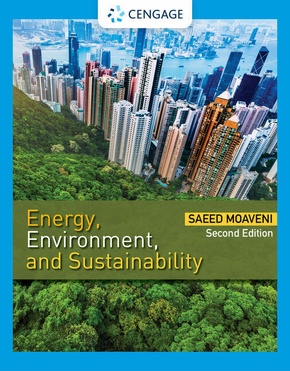Energy, Environment, and Sustainability
| Verlag | Cengage Learning EMEA |
| Auflage | 2022 |
| Seiten | 480 |
| Format | 20,3 x 2,0 x 25,4 cm |
| Gewicht | 930 g |
| Artikeltyp | Englisches Buch |
| EAN | 9780357676073 |
| Bestell-Nr | 35767607EA |
Gain a better understanding of the connections among earth's finite resources and the environmental, social, ethical, technical and economical impacts of your daily decisions with Moaveni's ENERGY, ENVIRONMENT, AND SUSTAINABILITY, 2nd Edition. As climate change has an increasing influence on today's world, you learn how to evaluate energy and environmental footprints to make environmentally sound decisions and help preserve natural resources. Become more aware of your own energy consumption as you study how much energy is required to manufacture, transport, use and dispose of common products. A new chapter highlights evidence-based analysis and how this systematic approach to sustainability can lead to more reliable decisions. Relevant, everyday examples bring concepts to life, while hands-on problems give you experience in analyzing information, preparing reports and presentations and working within teams. WebAssign digital resources further strengthen your understanding.
Inhaltsverzeichnis:
Part I: BASIC CONCEPTS.1. Introduction to Energy, Environment, and Sustainability.Basic Human Needs. Energy. Environment. Sustainability. Summary. Problems.2. Fundamental Dimensions and Systems of Units.Fundamental Dimensions and Units. Systems of Units. Dimensional Homogeneity and Unit Conversion. Components and Systems. Summary. Problems.3. Evidence-Based Data Analysis.Evidence-Based Analysis. Linear Models. Probability and Statistics. Statistics - Basic Ideas. Frequency Distributions. Mean, Median, and Standard Deviation. Normal Distribution. Summary. Problems.4. Electronic SpreadsheetsMicrosoft Excel Basics. Excel Functions. Plotting with Excel. Summary. Problems.Part II: ENERGY.5. Energy and Power.Energy. Forms of Energy. Difference Between Energy and Power. Energy Content (Heating Values) of Fuels. Summary. Problems.6. Electricity.Current, Voltage, and Electric Power - Basic Concepts. Residential Power Distribution and Consumption. Lighting Systems. Electric Power Generation , Transmission, and Distribution. Summary. Problems.7. Thermal Energy: Heat Loss and Gain in Buildings.Temperature Difference and Heat Transfer - Basic Concepts. Modes of Heat Transfer. Daylighting. Degree Days and Energy Estimation. Summary. Problems.8. Energy Consumption Rates and Non-Renewable Energy Sources.World Energy Consumption Rates. United States Energy Consumption Rates. Fossil Fuels. Nuclear Energy. Summary. Problems.9. Renewable Energy.Solar Energy. Solar Systems. Wind Energy. Hydro-Energy. Biomass. Summary. Problems.Part III: ENVIRONMENT.10. Air and Air Quality Standards.Atmosphere, Weather, and Climate. Outdoor Air Quality Standards in the United States. Indoor Air Quality Standards in the United States. Global Air Quality Issues. Summary. Problems.11. Water Resources, Consumption Rates, and Quality Standards.Water - Basic Concepts. Personal Water Consumption. Water Consumption in Agriculture, Commercial, and Industrial Sectors. Drinking Water Standards in the Unite d States. Global Water Quality Issues. Summary. Problems.12. Understanding the Materials We Use in Our Daily Lives.Earth - Our Home. The Phases of Matter and Properties of Materials. Metals. Plastics, Glass, Composites, and Wood. Concrete. Summary. Problems.13. Municipal and Industrial Waste and Recycling.Municipal Waste. Industrial Waste. Recycling and Composting. Summary. Problems.Part IV: SUSTAINABILITY.14. Sustainability.How Does One Define Sustainability? The Earth Chapter. Key Sustainability Concepts, Assessment, and Tools. Apply What You Have Learned - Knowledge is Power. Summary. Problems.

